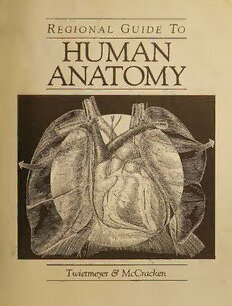
Regional guide to human anatomy PDF
Preview Regional guide to human anatomy
Regional Guide To HUMAN ANATOMY Tudetmeyer & McCracken REGIONAL GUIDE TO HUMAN ANATOMY Digitized by the Internet Archive in 2018 with funding from Kahle/Austin Foundation https://archive.org/details/regionalguidetohOOOOtwie REGIONAL GUIDE TO HUMAN ANATOMY Alan Twietmeyer, Ph.D. Associate Professor and Chairman Division of Physical Education Concordia College Ann Arbor, Michigan (formerly of Colorado State University) Thomas McCracken, M.S. Office of Biomedical Media and Department of Anatomy Colorado State University Fort Collins, Colorado Lea & Febiger Philadelphia 1988 Lea & Febiger 600 South Washington Square Philadelphia, PA 19106-4198 U.S.A. (215) 922-1330 Library of Congress Cataloging-in-Publication Data Twietmeyer, Alan. Regional guide to human anatomy. 1. Anatomy, Surgical and topographical—- Outlines, syllabi, etc. I. McCracken, Thomas. II. Title. [DNLM: 1. Anatomy, Regional. QS 4 T972r] QM531.T85 1988 611'.9 87-16944 ISBN 0-8121-1103-6 Copyright © 1988 by Lea & Febiger. Copyright under the International Copyright Union. All rights reserved. This book is protected by copyright. No part of it may be reproduced in any manner or by any means without written permission of the Publisher. Printed in the United States of America Print Number: 5 4 3 2 1 To my loving and patient wife, Patricia, and our seven wonderful children: Geoffry, Andrew, Greggory, Julie, Jennifer, Janell and Nathanael To my son, Sean, who put up with me during this endeavor PREFACE GOAL The goal of this guide/workbook is to provide students with a conceptual format for the study of gross human anatomy. The outline format and minimal text allows the student and instructor to work together in deciding which portions to include or exclude, thus allowing this book to be used in a variety of course levels. The authors feel that introductory human anatomy courses often do a disservice to the students by concentrating on specific facts while ignoring the conceptual picture and by not linking such concepts to the students’ career objectives. AUDIENCE Because of its modified outline approach this book is not self limiting to courses taught to certain groups of students or courses taught with or without laboratories. The most obvious audience includes students in allied health fields: physical education, occupational therapy, physical therapy, and athletic training or majors in biology, zoology, or art. However, enough factual information is presented in an easily accessible manner for this book to be an appropriate review source for students in medicine, dentistry, and nursing. APPROACH AND RATIONALE Two approaches are interwoven in this guide. One is the approach of presenting material regionally. The authors believe that such an approach aids the student in creating an understanding of the interrelationship of anatomic structures. The second approach is one of doing. The illustrations are provided with identifying letters or numbers in accordance with the outline, but the student should label these. Other structures associated with a particular illustration may also be labelled by the learner. The authors encourage any active participation such as coloring and notation. In addition many opportunities are provided for listing the attachments and innervation of muscles. Each exercise is followed by a section called FOR REVIEW AND THOUGHT in which the student is to actively review key items individually or with a partner. The overall intent is to thoroughly involve the learner in the material. The modified outline format to this book is the key to its goals. Such a format allows an instructor to eliminate a particular section that his/her course may not deal with or to accentuate a section he/she considers more important than others. From the student’s point of view this format allows nearly immediate access to facts without wading through voluminous textual material. It is the authors’ hope that this approach will provide teacher and student with an enjoyable and challenging foray into the study of human anatomy. The ideas and methods incorporated in this book incubated in the authors’ minds for several years where they were kept warm by frequent discussion and criticism and the advice of colleagues. The authors would especially like to thank Dr. Robert Tallitsch, Augustance College, Rock Island, Illinois and Dr. Jerry A. Maynard, University of Iowa, Iowa City, Iowa for their willingness to read the draft manuscript and their helpful suggestions. The manuscript was typed by Mrs. Sandra Swets, paste-up and cover design by David Carlson and photography by Jerry Mead. We thank them for their patience and understanding during the generation of the final manuscript. Special thanks are due Mr. George Mundorff, Executive Editor, Lea and Febiger, who embraced this effort with enthusiasm and provided encouragement and guidance. We are also grateful to Dorothy DiRienzi, Copy Editor, and Tom Colaiezzi, Production Manager, Lea and Febiger for their assistance and to all at the Publisher who aided in the pro¬ duction of this book. Ann Arbor, Michigan ALAN TWIETMEYER Fort Collins, Colorado THOMAS MCCRACKEN
